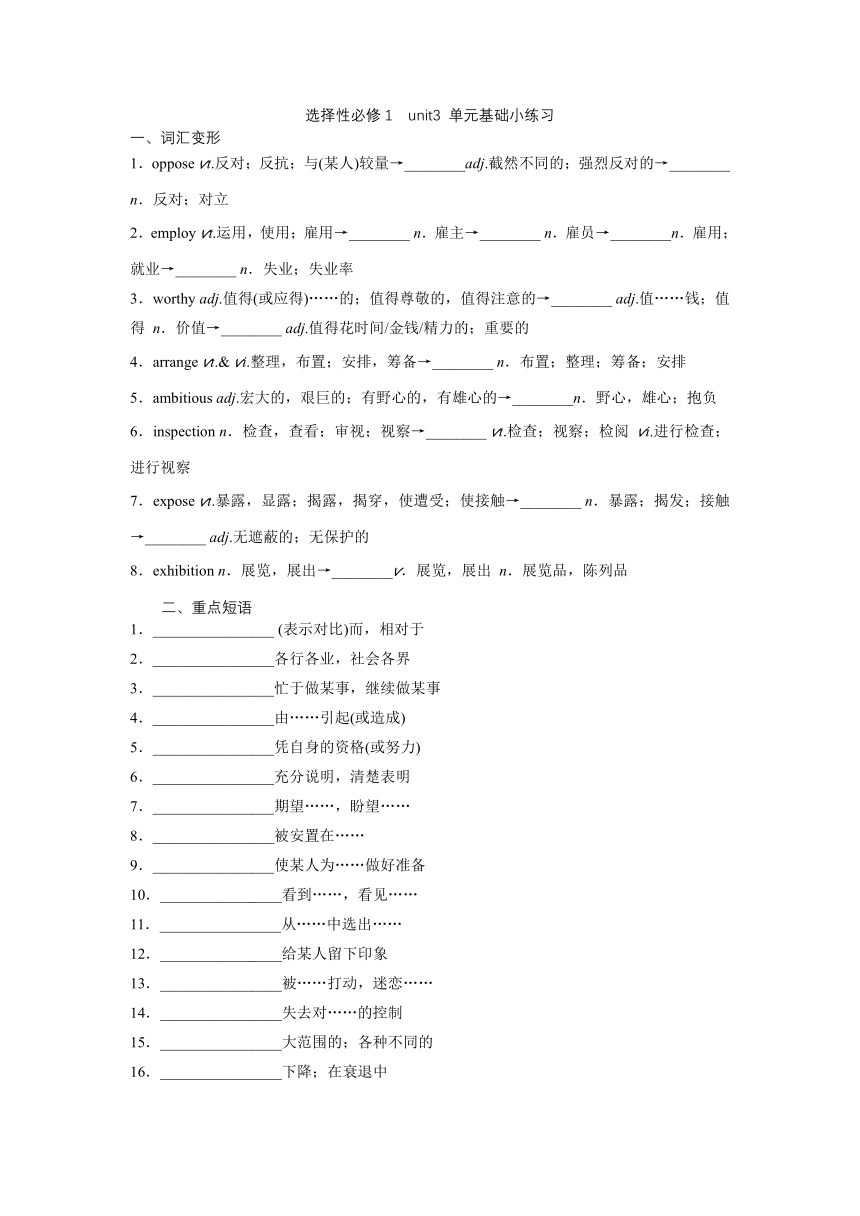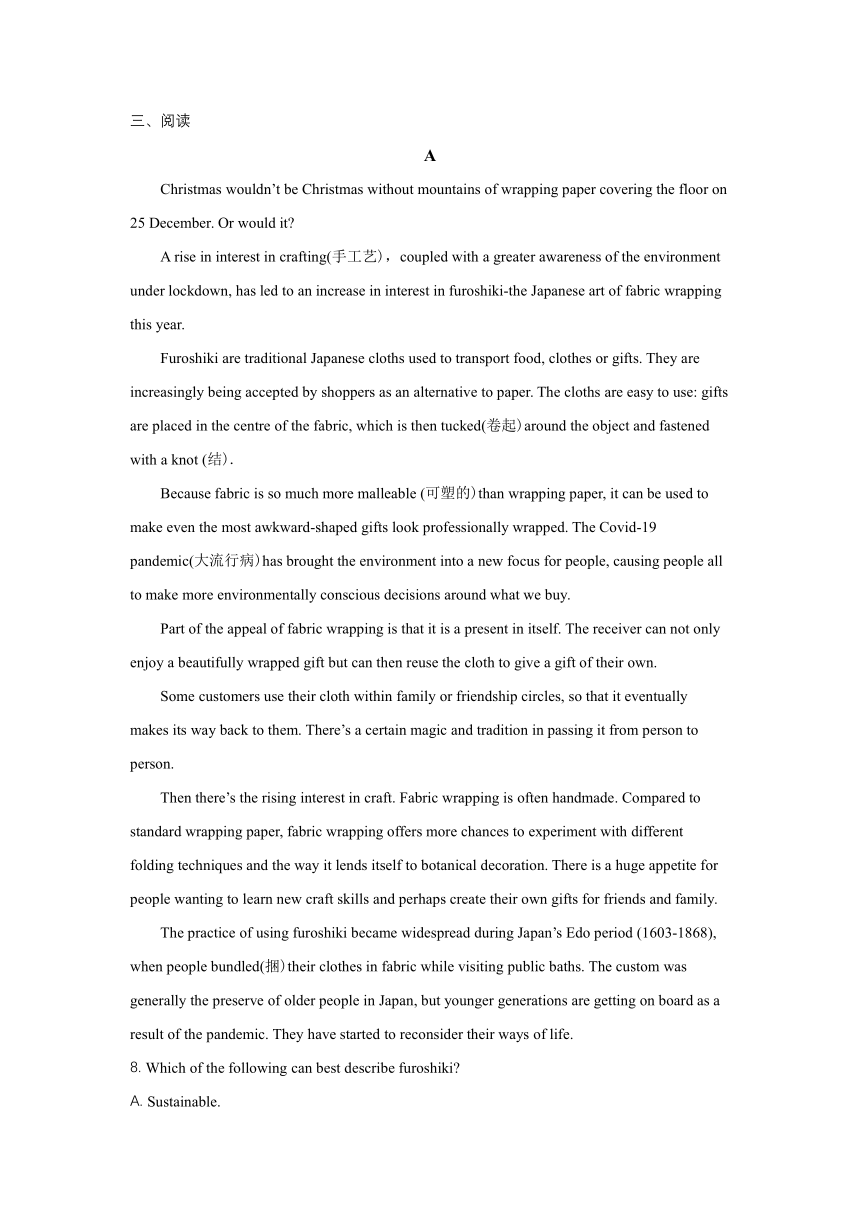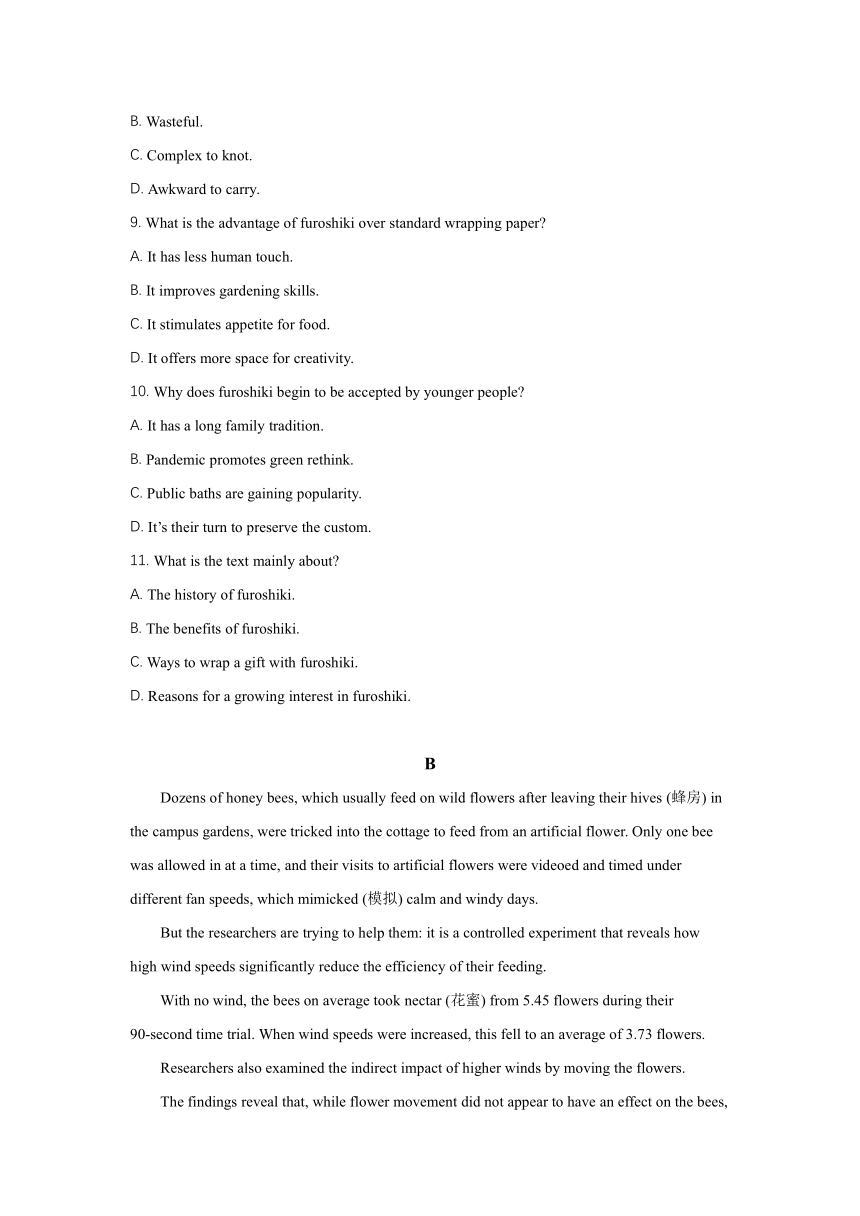牛津译林版(2019)选择性必修第一册Unit 3 The Art of Painting 单元基础小练习(含答案)
文档属性
| 名称 | 牛津译林版(2019)选择性必修第一册Unit 3 The Art of Painting 单元基础小练习(含答案) |

|
|
| 格式 | docx | ||
| 文件大小 | 26.6KB | ||
| 资源类型 | 教案 | ||
| 版本资源 | 牛津译林版(2019) | ||
| 科目 | 英语 | ||
| 更新时间 | 2022-10-08 22:55:17 | ||
图片预览




文档简介
选择性必修1 unit3 单元基础小练习
一、词汇变形
1.oppose vt.反对;反抗;与(某人)较量→________adj.截然不同的;强烈反对的→________ n.反对;对立
2.employ vt.运用,使用;雇用→________ n.雇主→________ n.雇员→________n.雇用;就业→________ n.失业;失业率
3.worthy adj.值得(或应得)……的;值得尊敬的,值得注意的→________ adj.值……钱;值得 n.价值→________ adj.值得花时间/金钱/精力的;重要的
4.arrange vt.& vi.整理,布置;安排,筹备→________ n.布置;整理;筹备;安排
5.ambitious adj.宏大的,艰巨的;有野心的,有雄心的→________n.野心,雄心;抱负
6.inspection n.检查,查看;审视;视察→________ vt.检查;视察;检阅 vi.进行检查;进行视察
7.expose vt.暴露,显露;揭露,揭穿,使遭受;使接触→________ n.暴露;揭发;接触→________ adj.无遮蔽的;无保护的
8.exhibition n.展览,展出→________v.展览,展出 n.展览品,陈列品
二、重点短语
1.________________ (表示对比)而,相对于
2.________________各行各业,社会各界
3.________________忙于做某事,继续做某事
4.________________由……引起(或造成)
5.________________凭自身的资格(或努力)
6.________________充分说明,清楚表明
7.________________期望……,盼望……
8.________________被安置在……
9.________________使某人为……做好准备
10.________________看到……,看见……
11.________________从……中选出……
12.________________给某人留下印象
13.________________被……打动,迷恋……
14.________________失去对……的控制
15.________________大范围的;各种不同的
16.________________下降;在衰退中
三、阅读
A
Christmas wouldn’t be Christmas without mountains of wrapping paper covering the floor on 25 December. Or would it
A rise in interest in crafting(手工艺),coupled with a greater awareness of the environment under lockdown, has led to an increase in interest in furoshiki-the Japanese art of fabric wrapping this year.
Furoshiki are traditional Japanese cloths used to transport food, clothes or gifts. They are increasingly being accepted by shoppers as an alternative to paper. The cloths are easy to use: gifts are placed in the centre of the fabric, which is then tucked(卷起)around the object and fastened with a knot (结).
Because fabric is so much more malleable (可塑的)than wrapping paper, it can be used to make even the most awkward-shaped gifts look professionally wrapped. The Covid-19 pandemic(大流行病)has brought the environment into a new focus for people, causing people all to make more environmentally conscious decisions around what we buy.
Part of the appeal of fabric wrapping is that it is a present in itself. The receiver can not only enjoy a beautifully wrapped gift but can then reuse the cloth to give a gift of their own.
Some customers use their cloth within family or friendship circles, so that it eventually makes its way back to them. There’s a certain magic and tradition in passing it from person to person.
Then there’s the rising interest in craft. Fabric wrapping is often pared to standard wrapping paper, fabric wrapping offers more chances to experiment with different folding techniques and the way it lends itself to botanical decoration. There is a huge appetite for people wanting to learn new craft skills and perhaps create their own gifts for friends and family.
The practice of using furoshiki became widespread during Japan’s Edo period (1603-1868), when people bundled(捆)their clothes in fabric while visiting public baths. The custom was generally the preserve of older people in Japan, but younger generations are getting on board as a result of the pandemic. They have started to reconsider their ways of life.
8. Which of the following can best describe furoshiki
A. Sustainable.
B. Wasteful.
C. Complex to knot.
D. Awkward to carry.
9. What is the advantage of furoshiki over standard wrapping paper
A. It has less human touch.
B. It improves gardening skills.
C. It stimulates appetite for food.
D. It offers more space for creativity.
10. Why does furoshiki begin to be accepted by younger people
A. It has a long family tradition.
B. Pandemic promotes green rethink.
C. Public baths are gaining popularity.
D. It’s their turn to preserve the custom.
11. What is the text mainly about
A. The history of furoshiki.
B. The benefits of furoshiki.
C. Ways to wrap a gift with furoshiki.
D. Reasons for a growing interest in furoshiki.
B
Dozens of honey bees, which usually feed on wild flowers after leaving their hives (蜂房) in the campus gardens, were tricked into the cottage to feed from an artificial flower. Only one bee was allowed in at a time, and their visits to artificial flowers were videoed and timed under different fan speeds, which mimicked (模拟) calm and windy days.
But the researchers are trying to help them: it is a controlled experiment that reveals how high wind speeds significantly reduce the efficiency of their feeding.
With no wind, the bees on average took nectar (花蜜) from 5.45 flowers during their 90-second time trial. When wind speeds were increased, this fell to an average of 3.73 flowers.
Researchers also examined the indirect impact of higher winds by moving the flowers.
The findings reveal that, while flower movement did not appear to have an effect on the bees, the movement of air from the fans made them much more hesitant to take off from a flower, with time taken ranging from an initial 0.05 seconds to 54 seconds.
Georgia Hennessy, lead author of the research, said that one possible reason for the wind causing hesitancy was that small increases in wind speed reduced the bees’ body temperature, so they require longer to warm up the flight muscles required to take off.
“With wind speeds predicted to increase in the years ahead, understanding how we can help bees in a changing climate is becoming ever more pressing. Although we can’t do much to control or stop the wind, we can take steps to reduce its impact on bees, such as placing hives in sheltered locations,” said Hennessy.
The UN’s Food and Agriculture Organization warned last year that the decline in global bee populations was a “threat to global food security and diversity”.
Dave Goulson, professor of biology at the University of Sussex, said:“Bees already face many pressures in the modern world, such as loss of habitats and exposure to pesticides (杀虫剂), and a great many are in decline. Coping with increasingly windy weather under climate change may be the final straw.”
12. What task did the researchers set for the bees
A. Identifying the new route.
B. Surviving in extreme conditions.
C. Feeding under different wind speeds.
D. Distinguishing various kinds of flowers.
13. What probably makes a bee hesitant to take off from a flower
A. A full stomach.
B. Loss of balance.
C. Changed flower positions.
D. Reduced body temperature.
14. What can we do to reduce the impact of high winds on bees
A. Stop the wind.
B Restore their habitats.
C. Address climate change.
D. Prohibit the use of pesticides.
15. Which of the following can be a suitable title for the text
A. Loss of bees causes failure of food crops
B. Bees are on the decline as global heating worsens
C. Bees may struggle in winds caused by global warming
D. Artificial flowers are used for threatened bee populations
五:写作:
假定你是李华,暑假在伦敦学习,得知当地美术馆要剧版中国画展。请写一封信申请做志愿者,内容包括:
1.写信目的;
2.个人优势;
3.能做的事情。
注意::
1.词数100左右;
2.可以适当增加细节,以使行文连贯;
3.结束语已为你写好。
____________________________________________________________________________________________________________________________________________________________________________________________________________________________________________________________________________________________________________________________________________________________________________________________________________________________________________________________________________
Looking forward to your early reply.
Yours,
Li Hua.
答案:
一、词汇变形
1.compose vt.& vi.作曲;组成;撰写,使镇静→composer n.作曲家,作曲者
2.transform vi.& vt.(使)变形,(使)改观,(使)转化→transformation n.转化;转换;变形
3.adaptation n.改编本,改写本;适应→adapt vt.使适应;改编 vi.适应→adaptable adj.有适应能力的,能适应的
4.defend vt.& vi.保护,防御;辩白,辩解→defence n.防御;防卫;保护
5.greet vt.问候,欢迎,招呼→greeting n.问候,招呼;(pl.)祝词;贺词
6.suitable adj.合适的,适宜的,适当的,适用的→suit v.对……合适;合身;适合;使适宜 n.套装,西装
7.distant adj.遥远的,远处的,久远的;冷淡的;远亲的→distance n.距离;远方
8.breath n.呼吸的空气;一次吸入的空气;微量,迹象→breathe vi.呼吸
9.expectation n.希望,盼望;预料,预期;期望,指望→expect vt.期望;指望;认为;预料 vi.期待;预期
10.enthusiastic adj.热情的,热心的→enthusiasm n.热心,热忱,热情
11.gifted adj.有才华的,有天赋的→gift n.礼物;天赋;赠品
12.prediction n.预言,预测→predict v.预言,预知;断言
13.depress vt.使抑郁,使沮丧;使萧条,使不景气→depressed adj.沮丧的;萧条的→depression n.抑郁(症);消沉;萧条(期)
14.possess vt.具有(特质);拥有;支配,控制→possession n.拥有;(pl.)财产;财物
二、重点短语
1.tear apart使(关系密切的人)分离,分开
2.rely on依赖,依靠;信任
3.for good measure作为额外增添
4.throw in奉送,额外赠送
5.consist of由……组成(或构成)
6.get down to (doing) sth.开始做某事,开始认真注意(或对待)某事
7.all of a sudden突然,猛地
8.turn out最后是,结果是
9.be well received深受欢迎
10.be capable of doing sth.能够做某事;有能力做某事
11.stream into不断涌进;源源不断地流入
12.break into突然开始(做某事);闯入;破门而入
阅读理解
【答案】1. A 2. D 10. B 11. D
【答案】12. C 13. D 14. C 15. C
写作
Dear sir or madam,
I am a Chinese student named Li Hua, who is studying in London during the summer vacation. Knowing that the local art gallery will hold an exhibition of Chinese paintings, I am writing to apply for volunteering. As a student who has learned Chinese painting since 5 years old, I am very pleased to have an opportunity to introduce Chinese paintings to foreigners. Besides, my fluent spoken English and rich knowledge about Chinese paintings will help visitors understand the meaning behind each painting deeply. I will appreciate it if I could be given the opportunity.
Looking forward to your early reply.
Yours,
Li Hua.
一、词汇变形
1.oppose vt.反对;反抗;与(某人)较量→________adj.截然不同的;强烈反对的→________ n.反对;对立
2.employ vt.运用,使用;雇用→________ n.雇主→________ n.雇员→________n.雇用;就业→________ n.失业;失业率
3.worthy adj.值得(或应得)……的;值得尊敬的,值得注意的→________ adj.值……钱;值得 n.价值→________ adj.值得花时间/金钱/精力的;重要的
4.arrange vt.& vi.整理,布置;安排,筹备→________ n.布置;整理;筹备;安排
5.ambitious adj.宏大的,艰巨的;有野心的,有雄心的→________n.野心,雄心;抱负
6.inspection n.检查,查看;审视;视察→________ vt.检查;视察;检阅 vi.进行检查;进行视察
7.expose vt.暴露,显露;揭露,揭穿,使遭受;使接触→________ n.暴露;揭发;接触→________ adj.无遮蔽的;无保护的
8.exhibition n.展览,展出→________v.展览,展出 n.展览品,陈列品
二、重点短语
1.________________ (表示对比)而,相对于
2.________________各行各业,社会各界
3.________________忙于做某事,继续做某事
4.________________由……引起(或造成)
5.________________凭自身的资格(或努力)
6.________________充分说明,清楚表明
7.________________期望……,盼望……
8.________________被安置在……
9.________________使某人为……做好准备
10.________________看到……,看见……
11.________________从……中选出……
12.________________给某人留下印象
13.________________被……打动,迷恋……
14.________________失去对……的控制
15.________________大范围的;各种不同的
16.________________下降;在衰退中
三、阅读
A
Christmas wouldn’t be Christmas without mountains of wrapping paper covering the floor on 25 December. Or would it
A rise in interest in crafting(手工艺),coupled with a greater awareness of the environment under lockdown, has led to an increase in interest in furoshiki-the Japanese art of fabric wrapping this year.
Furoshiki are traditional Japanese cloths used to transport food, clothes or gifts. They are increasingly being accepted by shoppers as an alternative to paper. The cloths are easy to use: gifts are placed in the centre of the fabric, which is then tucked(卷起)around the object and fastened with a knot (结).
Because fabric is so much more malleable (可塑的)than wrapping paper, it can be used to make even the most awkward-shaped gifts look professionally wrapped. The Covid-19 pandemic(大流行病)has brought the environment into a new focus for people, causing people all to make more environmentally conscious decisions around what we buy.
Part of the appeal of fabric wrapping is that it is a present in itself. The receiver can not only enjoy a beautifully wrapped gift but can then reuse the cloth to give a gift of their own.
Some customers use their cloth within family or friendship circles, so that it eventually makes its way back to them. There’s a certain magic and tradition in passing it from person to person.
Then there’s the rising interest in craft. Fabric wrapping is often pared to standard wrapping paper, fabric wrapping offers more chances to experiment with different folding techniques and the way it lends itself to botanical decoration. There is a huge appetite for people wanting to learn new craft skills and perhaps create their own gifts for friends and family.
The practice of using furoshiki became widespread during Japan’s Edo period (1603-1868), when people bundled(捆)their clothes in fabric while visiting public baths. The custom was generally the preserve of older people in Japan, but younger generations are getting on board as a result of the pandemic. They have started to reconsider their ways of life.
8. Which of the following can best describe furoshiki
A. Sustainable.
B. Wasteful.
C. Complex to knot.
D. Awkward to carry.
9. What is the advantage of furoshiki over standard wrapping paper
A. It has less human touch.
B. It improves gardening skills.
C. It stimulates appetite for food.
D. It offers more space for creativity.
10. Why does furoshiki begin to be accepted by younger people
A. It has a long family tradition.
B. Pandemic promotes green rethink.
C. Public baths are gaining popularity.
D. It’s their turn to preserve the custom.
11. What is the text mainly about
A. The history of furoshiki.
B. The benefits of furoshiki.
C. Ways to wrap a gift with furoshiki.
D. Reasons for a growing interest in furoshiki.
B
Dozens of honey bees, which usually feed on wild flowers after leaving their hives (蜂房) in the campus gardens, were tricked into the cottage to feed from an artificial flower. Only one bee was allowed in at a time, and their visits to artificial flowers were videoed and timed under different fan speeds, which mimicked (模拟) calm and windy days.
But the researchers are trying to help them: it is a controlled experiment that reveals how high wind speeds significantly reduce the efficiency of their feeding.
With no wind, the bees on average took nectar (花蜜) from 5.45 flowers during their 90-second time trial. When wind speeds were increased, this fell to an average of 3.73 flowers.
Researchers also examined the indirect impact of higher winds by moving the flowers.
The findings reveal that, while flower movement did not appear to have an effect on the bees, the movement of air from the fans made them much more hesitant to take off from a flower, with time taken ranging from an initial 0.05 seconds to 54 seconds.
Georgia Hennessy, lead author of the research, said that one possible reason for the wind causing hesitancy was that small increases in wind speed reduced the bees’ body temperature, so they require longer to warm up the flight muscles required to take off.
“With wind speeds predicted to increase in the years ahead, understanding how we can help bees in a changing climate is becoming ever more pressing. Although we can’t do much to control or stop the wind, we can take steps to reduce its impact on bees, such as placing hives in sheltered locations,” said Hennessy.
The UN’s Food and Agriculture Organization warned last year that the decline in global bee populations was a “threat to global food security and diversity”.
Dave Goulson, professor of biology at the University of Sussex, said:“Bees already face many pressures in the modern world, such as loss of habitats and exposure to pesticides (杀虫剂), and a great many are in decline. Coping with increasingly windy weather under climate change may be the final straw.”
12. What task did the researchers set for the bees
A. Identifying the new route.
B. Surviving in extreme conditions.
C. Feeding under different wind speeds.
D. Distinguishing various kinds of flowers.
13. What probably makes a bee hesitant to take off from a flower
A. A full stomach.
B. Loss of balance.
C. Changed flower positions.
D. Reduced body temperature.
14. What can we do to reduce the impact of high winds on bees
A. Stop the wind.
B Restore their habitats.
C. Address climate change.
D. Prohibit the use of pesticides.
15. Which of the following can be a suitable title for the text
A. Loss of bees causes failure of food crops
B. Bees are on the decline as global heating worsens
C. Bees may struggle in winds caused by global warming
D. Artificial flowers are used for threatened bee populations
五:写作:
假定你是李华,暑假在伦敦学习,得知当地美术馆要剧版中国画展。请写一封信申请做志愿者,内容包括:
1.写信目的;
2.个人优势;
3.能做的事情。
注意::
1.词数100左右;
2.可以适当增加细节,以使行文连贯;
3.结束语已为你写好。
____________________________________________________________________________________________________________________________________________________________________________________________________________________________________________________________________________________________________________________________________________________________________________________________________________________________________________________________________________
Looking forward to your early reply.
Yours,
Li Hua.
答案:
一、词汇变形
1.compose vt.& vi.作曲;组成;撰写,使镇静→composer n.作曲家,作曲者
2.transform vi.& vt.(使)变形,(使)改观,(使)转化→transformation n.转化;转换;变形
3.adaptation n.改编本,改写本;适应→adapt vt.使适应;改编 vi.适应→adaptable adj.有适应能力的,能适应的
4.defend vt.& vi.保护,防御;辩白,辩解→defence n.防御;防卫;保护
5.greet vt.问候,欢迎,招呼→greeting n.问候,招呼;(pl.)祝词;贺词
6.suitable adj.合适的,适宜的,适当的,适用的→suit v.对……合适;合身;适合;使适宜 n.套装,西装
7.distant adj.遥远的,远处的,久远的;冷淡的;远亲的→distance n.距离;远方
8.breath n.呼吸的空气;一次吸入的空气;微量,迹象→breathe vi.呼吸
9.expectation n.希望,盼望;预料,预期;期望,指望→expect vt.期望;指望;认为;预料 vi.期待;预期
10.enthusiastic adj.热情的,热心的→enthusiasm n.热心,热忱,热情
11.gifted adj.有才华的,有天赋的→gift n.礼物;天赋;赠品
12.prediction n.预言,预测→predict v.预言,预知;断言
13.depress vt.使抑郁,使沮丧;使萧条,使不景气→depressed adj.沮丧的;萧条的→depression n.抑郁(症);消沉;萧条(期)
14.possess vt.具有(特质);拥有;支配,控制→possession n.拥有;(pl.)财产;财物
二、重点短语
1.tear apart使(关系密切的人)分离,分开
2.rely on依赖,依靠;信任
3.for good measure作为额外增添
4.throw in奉送,额外赠送
5.consist of由……组成(或构成)
6.get down to (doing) sth.开始做某事,开始认真注意(或对待)某事
7.all of a sudden突然,猛地
8.turn out最后是,结果是
9.be well received深受欢迎
10.be capable of doing sth.能够做某事;有能力做某事
11.stream into不断涌进;源源不断地流入
12.break into突然开始(做某事);闯入;破门而入
阅读理解
【答案】1. A 2. D 10. B 11. D
【答案】12. C 13. D 14. C 15. C
写作
Dear sir or madam,
I am a Chinese student named Li Hua, who is studying in London during the summer vacation. Knowing that the local art gallery will hold an exhibition of Chinese paintings, I am writing to apply for volunteering. As a student who has learned Chinese painting since 5 years old, I am very pleased to have an opportunity to introduce Chinese paintings to foreigners. Besides, my fluent spoken English and rich knowledge about Chinese paintings will help visitors understand the meaning behind each painting deeply. I will appreciate it if I could be given the opportunity.
Looking forward to your early reply.
Yours,
Li Hua.
同课章节目录
- Unit 1 Food matters
- Welcome to the unit
- Reading
- Grammar and usage
- Integrated skills
- Extended reading
- Project
- Unit 2 The Universal Language
- Welcome to the unit
- Reading
- Grammar and usage
- Integrated skills
- Extended reading
- Project
- Unit 3 The art of painting
- Welcome to the unit
- Reading
- Grammar and usage
- Integrated skills
- Extended reading
- Project
- Unit 4 Exploring poetry
- Welcome to the unit
- Reading
- Grammar and usage
- Integrated skills
- Extended reading
- Project
